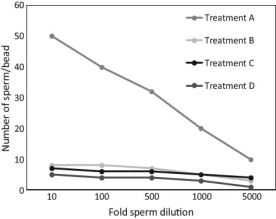Use the following information to answer the question.
In order to test how sea urchin sperm bind to eggs, scientists isolated the egg receptor protein that binds to the sperm acrosomal protein called bindin. Plastic beads were coated with egg receptor for bindin (ERB1) from eggs of the sea urchin Strongylocentrotus purpuratus, and then the beads mixed with sperm from S. purpuratus or from the related species, S. franciscanus. The researchers counted how many sperm were bound to each bead. The results are shown in the graph below. (Adapted from Kamei and Glabe 2003)
Treatments:
A: S. purpuratus sperm mixed with S. purpuratus ERB1 beads
B: S. purpuratus sperm mixed with beads containing no ERB1 protein
C: S. franciscanus sperm mixed with S. purpuratus ERB1 beads
D: S. franciscanus sperm mixed with beads containing no ERB1 protein
Based on the data in the graph, which of the following conclusions is supported?
A) Plastic beads will bind to sperm from both species of sea urchin.
B) ERB1 prevents S. franciscanus sperm from binding the beads.
C) Sperm from S. purpuratus bind to beads only if ERB1 is present.
D) S. franciscanus and S. purpuratus are actually the same species.
Correct Answer:
Verified
Q14: In mammalian eggs, the receptors for sperm
Q15: At the moment of sperm penetration, human
Q16: In sea urchins, the "fast block" and
Q17: The formation of the fertilization envelope requires
Q18: Even in the absence of sperm, metabolic
Q20: The pattern of embryonic development in which
Q21: Thalidomide, now banned for use as a
Q22: The cortical reaction of sea urchin eggs
Q23: In all vertebrate animals, development requires _.
A)
Q24: The least amount of yolk would be
Unlock this Answer For Free Now!
View this answer and more for free by performing one of the following actions

Scan the QR code to install the App and get 2 free unlocks

Unlock quizzes for free by uploading documents